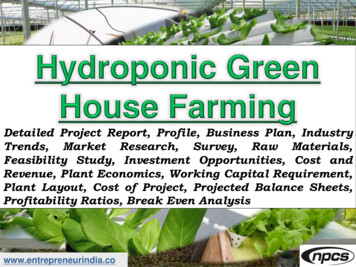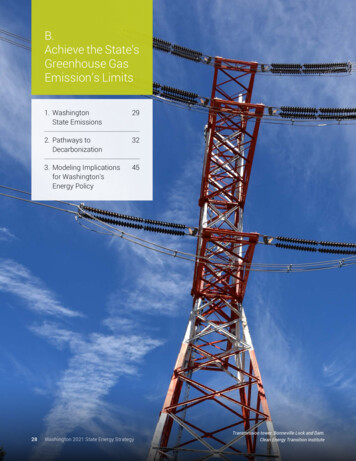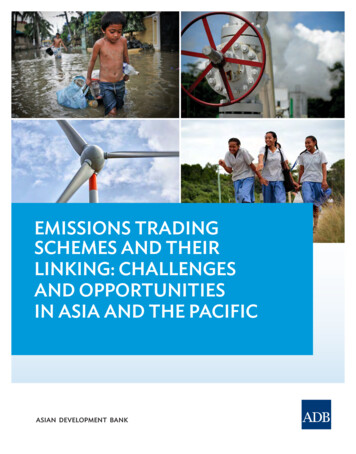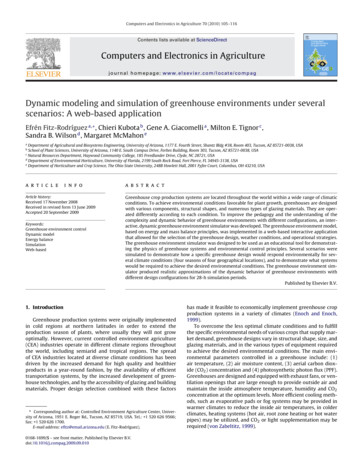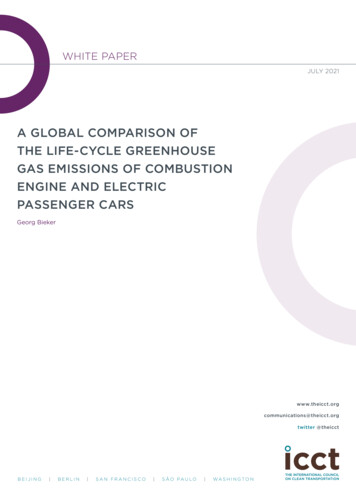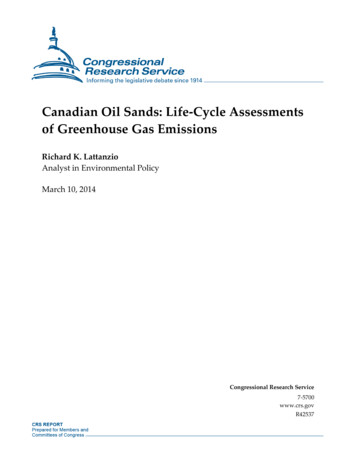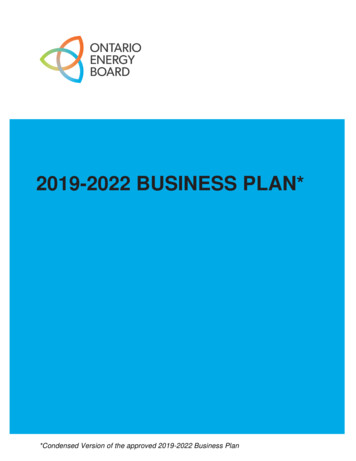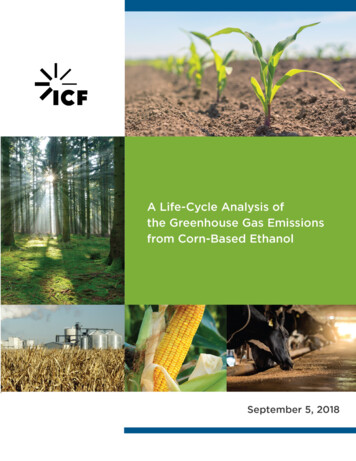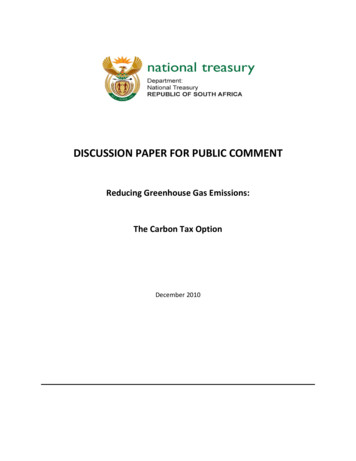
Transcription
DISCUSSION PAPER FOR PUBLIC COMMENTReducing Greenhouse Gas Emissions:The Carbon Tax OptionDecember 2010
2ContentsOverview . 31: Background . 112: Introduction . 133: Climate change and its effects . 153.1Effects of climate change . 153.2Greenhouse gas emissions profile for South Africa . 164: Economics of climate change. 204.1Externalities . 204.2External and social costs of carbon. 225: Policy instruments to address climate change . 255.1Market-based instruments versus command and control measures . 255.2Environmentally related - Pigouvian taxation . 265.3Carbon pricing options: carbon taxes and emissions trading schemes . 276: Tax policy design considerations . 306.1Tax base and administration . 306.2Tax incidence - distributional effects . 376.3Competitiveness. 396.4Border tax adjustments . 407: International practice . 438: Revenue use – recycling, tax shifting and earmarking. 509: Potential effects of carbon taxation . 529.1Summary of economic modelling studies on the potential economic impact of carbon taxes . 5210: Summary . 58References . 60Annexure 1: Social costs of carbon . 62Annexure 2: International examples. 63Annexure 3: Economic efficiency gains of market-based instruments. 74Annexure 4: Acronyms . 75
3OverviewIntroductionClimate change is a serious global problem that requires both a concerted international response andnational efforts to reduce greenhouse gas (GHG) emissions.The United Nations Framework Convention on Climate Change (UNFCCC) is the main global response toclimate change. The associated Kyoto Protocol is an international agreement that classifies countries bytheir level of industrialisation and commits certain countries to GHG emission-reduction targets. TheKyoto Protocol commits annex 1 (developed) countries to reduce GHG emissions to 5 per cent below1990 levels by 2012.South Africa, a non-annex 1 developing country, is ranked among the top 20 countries measured byabsolute carbon dioxide (CO2) emissions. The vast majority of South Africa’s CO2emissions (about80 per cent) are produced by the electricity sector, the metals industry and the transport sector. Theelectricity sector’s reliance on low-cost fossil fuels-based electricity generation is one of the mainreasons for the carbon-intensive nature of our economy. These already high levels of GHG emissions areexpected to increase as the economy grows.Government is of the view that South Africa needs to reduce GHG emissions while working to ensureeconomic growth, increase employment, and reduce poverty and inequality. These goals are notnecessarily mutually exclusive. Environmentally related taxes have an important role to play indiscouraging activities that impose high social costs and in helping to ensure that economic growth anddevelopment are sustainable.During the 2009 Copenhagen climate change negotiations, South Africa voluntarily announced that itwould act to reduce domestic GHG emissions by 34 per cent by 2020 and 42 per cent by 2025 frombusiness as usual subject to the availability of adequate financial, technological and other support.To combat climate change, which is by definition a global problem, a full-scale worldwide response isrequired. While there is a degree of global cooperation, a fully coordinated and concerted response isnot on the immediate horizon: governments are unlikely to reach consensus on an equitable burden ofshared responsibility for emissions reductions, or on an international carbon price, in the near future.The Long-Term Mitigation Scenarios report (2007) and the National Climate Change Response GreenPaper (2010) for South Africa recommends the use of market-based instruments, specifically carbontaxes, to induce behavioural changes that contribute to lower GHG emissions. The role of suchinstruments to address climate change and support sustainable development has gained increasedprominence in recent years. All countries could price carbon domestically, outside of an internationalarrangement, as this presents opportunities to pursue emission reductions and revenue-raisingobjectives simultaneously.The two main economic policy instruments available for putting a price on carbon and curbing GHGemissions are carbon taxation and emissions trading schemes. The carbon tax seeks to reduceemissions through the price mechanism directly, while emissions trading schemes establishes targets for
4specific levels of emissions through the trade in allowances. To date, the relative merits and feasibility ofthese policies have been demonstrated primarily in Europe.Uniform application of carbon taxes, however, tends to be regressive, because a disproportionate shareof the tax burden falls on the poor. In a South African context, government would need to counteractthis tendency, addressing other economic development imperatives such as poverty alleviation, andensuring access to basic and affordable energy services for low-income households. The design of thetax should include compensating measures to minimise adverse impacts on low income households.This paper attempts to build on the work contained in the Environmental Fiscal Reform Policy Paper(2006) and considers the economic rationale for introducing a carbon tax.Climate change and its effectsOverwhelming scientific evidence has demonstrated the link between increasing atmosphericconcentrations of GHGs and rising global temperatures. Average temperatures have increased over thepast 50 years at a rate of 0.2 C per decade, largely as a result of human activity.Estimates suggest that if GHG emissions were stabilised at their 2006 levels, the atmosphericconcentration of these gases could reach 550ppm of carbon dioxide equivalent (CO2e), double its preindustrial level, by as early as 2035, committing the earth to an average temperature increase of about2-5 C. Even at the lower end of this scale, global warming is likely to have a serious impact on human lifeand the environment: South Africa and many other developing countries are especially vulnerable to the effects ofclimate change given our economic dependence on the primary sector (agriculture, fisheries,mining, etc). About 64 per cent of people in Southern Africa are employed in the primary sector.According to some estimates, a temperature increase of 3-4 C, could lead to a 15 per centdecline in African crop yields, with extremely negative consequences in sub-Saharan Africa,where only about 4 per cent of arable land is irrigated.Projections suggest that a global temperature increase of 3 C would reduce crop yields, leadingto food shortages for up to 550 million people, more than half of whom live in Africa.Warming is expected to increase mosquito prevalence, with a concomitant rise in malaria.Extreme weather patterns are predicted to reduce growth rates in many developing countries.Economic rationale for carbon taxesCommand and control regulations and market based instruments are used to control pollution.However, market-based policy instruments, which complement regulatory policy, provide for greaterflexibility in emissions reduction. Companies with low abatement costs 1 have an incentive to undertakefurther measures to avoid paying the tax, while firms with high marginal abatement costs will tend to doless.1Costs borne by a business for the removal and/or reduction of an undesirable item they have created – such as the costs ofreducing pollutants.
5The environment is essentially a “public good”: it is accessible to all and consumption of the good doesnot diminish availability. Climate change and its effects are the result of GHG emissions, which are notpaid for by the emitters. Such emissions impose external costs on society – an “externality” in economicterms. Because these costs have not been factored into the prices of goods and services, this is a“market failure”, which can be corrected by a pricing instrument.The need for government policy intervention to address climate change concerns stems mainly from thismarket failure. Moreover, the fact that external costs of damages are not reflected in final pricesencourages the over allocation of resources for the production and consumption of commodities.In this context, the pricing of environmental goods and services that generate excessive levels of GHGemissions should be adjusted to reflect the full costs of production and consumption. Carbon taxes canaccomplish this objective by encouraging lower emissions, greater energy efficiency and the use ofcleaner, low carbon technologies.The economic rationale for environmental taxation was developed by English economist Arthur Pigouduring the first half of the 20th century. 2A carbon tax is one way in which external costs can beinternalised into consumption and production decisions. The most efficient way to achieve such anoutcome would be to set a uniform tax rate that is equal to the marginal external cost from emitting anadditional unit of GHG. Most estimates of these marginal external costs are in the region of 5–30 perton of CO2, consistent with least-cost stabilisation of atmospheric CO2 concentrations at 550ppm (seeTable 4 on page 23).Efficiency considerations are important when economic instruments are used to correct market failures.Economic instruments, such as a carbon tax, have the potential to be more efficient than regulatorypolicy instruments. As noted earlier, a carbon tax would create an incentive for activities with the lowestcosts of abatement to reduce emissions while penalising those with high costs of abatement. Also,carbon taxes would generate revenues and may be easier to implement compared to regulatory policiesthat require substantial information on firms abatement costs.Overall, the use of market-based instruments can support environmental objectives at least cost to theeconomy. A carbon tax can help to internalise a negative externality– in other words, the external costsare integrated into the producers’ costs and consumer prices, creating incentives for changes inbehaviour.Carbon taxes versus emissions trading schemesAn Australian paper on reducing GHG pollution suggests that “The introduction of a carbon price willchange the relative prices of goods and services, making emission-intensive goods more expensiverelative to those that are less emissions-intensive. This provides a powerful incentive for consumers andbusinesses to adjust their behaviour, resulting in a reduction of emissions.” 3 However, theappropriateness of carbon taxes and emissions trading schemes to effectively price carbon, particularlyin a developing-country context, are the subject of debate.2Pigou, A. C. (1920)“The Economics of Welfare”. London: MacMillan.“Australia’s Low Pollution Future” (2008) White Paper Volume 1, December 2008, Carbon Pollution ReductionScheme.3
6Developing an adequate, low-cost and competitive emissions trading mechanism to protect theatmosphere is imperative. In the South African context, however, the oligopolistic structure of theenergy sector is likely to reduce efficiency gains that would result from such a mechanism. The lack ofmany industry players and appropriate market structure with diverse abatement costs suggests limitedopportunities for domestic trade, resulting in inappropriate permit prices. This could result in the lock-inof emission-intensive technologies where permits could be used as a barrier of entry for newcomers.There are other concerns about emissions trading systems. The European Union emissions tradingscheme (EUETS), for example, has experienced significant price volatility. Declining industrial activity inEurope and hence energy use, since the middle of 2008 in the face of fixed supply of carbon allowancesand declining emissions also contributed to falling carbon prices. 4The price of carbon under the EUscheme appears to be too low due to the large number of free allowance allocations among industrialusers, which results in economic distortions and the creation of unequal abatement incentives.A carbon tax regime would have certain administrative advantages over emissions trading schemes: Oversight of the tax by the existing revenue authority Fewer players involved (and therefore lower costs) A simpler structure, minimising opportunity for abuse and risk A lower administrative burden, because no new accounting system is required Lobbying efforts would be minimised.Although a carbon tax would not set a fixed quantitative limit for carbon emissions over the short term,a tax set at an appropriate level and phased in over time would provide a strong price signal to bothproducers and consumers to change their behaviour over the medium to long term.Design of carbon taxesThe following issues need to be carefully addressed in the design of a carbon tax: Environmental effectiveness – The ability of the tax to reduce GHG emissions.Rate of tax – To the degree possible, the tax rate should be aligned with the marginal externaldamage costs of each additional unit of CO2eemissions.Distributional implications – Government should take measures – either in tax design or throughcomplementary expenditure programmes – to offset the burden such a tax will place on poorhouseholds.Competitiveness – Industries that participate in international trade might be at a disadvantagewhen competing with countries that do not price carbon.Technical and administrative feasibility – Consideration needs to be given to whether the tax isplaced on carbon emissions or a proxy for such emissions (e.g. fuel inputs or outputs). Theadministrative and compliance costs of implementing the tax should be weighed against theneed to create the correct incentives.Aligning policy objectives – The tax should be aligned with other government policyinterventions. For example, policies to reduce energy sector carbon emissions should not beaccompanied by policy measures that seek to encourage such emissions.4 Ricard-Nihoul, E & Fabry, G (2010). The Contribution of 14 European Think Tanks to the Spanish, Belgian and Hungarian TrioPresidency of the European Union. Accessed on 13 August 2010 at: inal.pdf
7 Legislative provisions – Robust legislation should provide certainty to the taxpayer and minimiseopportunities for tax avoidance and evasion.Tax base and administrationTheoretically, taxes should be applied directly on the emissions of CO2. Other GHGs could be included inthe tax base however; this may be administratively complex and therefore impractical. In practice, it isdifficult and costly to measure emissions at source, especially when there are a large number of sources,which is often the case with GHGs. One solution is to define carbon taxes as a tax on the carbon contentof energy products, which serves as a proxy for actual emissions resulting from combustion.There are two options: an upstream tax at the point where fuels enter the economy, according to theircarbon content; or a downstream tax on emitters at the point where fuels are combusted. Theadministrative costs and complexity of an upstream tax are significantly lower.Arguably, an upstream tax does not provide adequate incentives to encourage carbon capture andstorage and includes sectors which use fuels for non-combustion purposes. These processes may beremoved from the tax base or given tax rebates.Impact on low-income householdsPoor households spend up to a quarter of their income on electricity, water and transport. The potentialimpact of a carbon tax on low-income households needs to be addressed through appropriatelytargeted compensating measures.A carbon tax would provide a revenue stream that could be used to support developmentalprogrammes – from reducing distortionary taxes such as payroll taxes, to targeted rollout of free basicservices such as electricity and water to poor households, to higher transfers to low- and middle-incomehouseholds. The phasing-in of carbon tax policies over a specific timeframe and initiatives to retrain ormove workers to alternate employment can help smooth the transition to a low carbon economy andminimise adverse impacts on employment.Competitiveness issues and border tax adjustmentsA carbon tax would have different effects on different businesses and industrial sectors, depending onfactors such as emission intensity and levels of participation in international markets. Some companiesmay be at a competitive disadvantage depending on their ability to pass the tax on to consumers bothdomestically and abroad, particularly if its competitors do not face similar tax regimes. Competitivenessconcerns should also be considered in the absence of a global agreement on carbon pricing.Competitiveness concerns may be addressed through gradually, phasing-in a carbon tax at a relativelymodest level initially and increasing over the medium to long term to reflect the full external costs.Clear price signals will provide certainty to key role players and encourage low carbon and energyefficient practises. Carbon taxes can also be designed to neutralise the effects on competitivenessthrough sectoral exemptions (which may also be differentiated) and tax reduction. These measures givecompanies time to adjust to policy shifts, but should be awarded only for a short transition period. Froman environmental point of view, exemptions for emissions-intensive sectors reduce the effectiveness of
8the tax and require concurrent increases in the tax rate for non-exempt sectors. Economically, sectoralexemptions create uneven abatement incentives across sectors, which risks abatement inefficiency.Some commentators have proposed border tax adjustments based on the carbon content of goods as away to defend competitiveness. Such taxes on imports would allow prices to reflect the comparativeadvantages of trading countries, and act as a disincentive to shift production to countries that have nocarbon pricing regime. There are, however, practical difficulties associated with border tax adjustments.The carbon content of many products is not readily available and adjustments would need to beharmonised between countries that trade and apply carbonpricing. Without harmonisation, productscould be subject to double taxation or zero taxation. There are also legal impediments associated withthe need to stay within World Trade Organisation (WTO) rules.It is argued that the early adoption of a low carbon growth path can create a competitive advantage forcountries taking cognisance of the effects of climate change and environmental pollution.International practiceSeveral countries have undertaken environmental tax reforms, transforming existing energy taxes tofocus on carbon content. They include Finland, the Netherlands, Sweden, Denmark and the UnitedKingdom.Carbon tax rates in these countries are usually set lower than the marginal external costs of climatechange, with the exception of taxes levied on transport fuels. Some of the main reasons for thisapproach are the lack of a global carbon pricing regime and concerns around industry competitivenessand the difficulties of estimating the actual external costs. A discussion of international experience withcarbon taxes is found in Section 7.Using carbon tax revenues: recycling, tax shifting and earmarkingThere is much debate on how environmental tax revenues should be used. Some form of revenuerecycling through tax shifting could be considered. This would involve taxing “bads” and reducing taxeson “goods” such as labour (i.e. payroll taxes). 5Neither public finance theory nor good public finance practice support the full earmarking of specificrevenue streams. There are several reasons for this approach: There is a risk of misallocation of public funds depending on the amount of money collectedfrom a specific tax, with too much or too little funding going to a target area.Earmarking might impose undue constraints on government in a way that serves special interestgroups. The state cannot allow special interests to capture public resources.Such practices may be an obstacle to continuous evaluation and modification of tax andspending programmes.The National Treasury does not support full earmarking of revenues generated from environmentaltaxes. However, partial “on-budget” earmarking of some revenue for specific (e.g. environmental or5Cuervo and Ghandi(1998) “Carbon taxes: their macroeconomic effects and prospects for global adoption – A surveyof the literature.” Fiscal Affairs Department, IMF, Washington.
9social) purposes may be appropriate to promote public and political acceptance of the benefits of thereform. Such arrangements should not undermine the normal budgetary process and should allowadequate funding for changes in government priorities.Potential impacts of carbon taxation for South AfricaConsideration of environmentally related taxes has been undertaken in line with the broad principles ofSouth Africa’s tax policy: efficiency, equity, administrative feasibility and simplicity.Government has already introduced several excise taxes and incentives to support the transition to anenvironmentally friendly, low-carbon economy. In addition to the fuel taxes on petrol and diesel, theelectricity levy of 2c/kWh was implemented in July 2009 as a step towards developing a comprehensivecarbon pricing regime. Tax incentives and specifically targeted government programmes for renewableenergy and energy efficiency measures form part of government’s policy response to climate change.This discussion document makes reference to several studies that attempt to assess the environmentaland economic effects and implications of a carbon tax. Two papers in particular are cited in thisdocument – the Long-Term Mitigation Scenarios (Department of Environmental Affairs and Tourism)and Tax Policy to Reduce Carbon Emissions in South Africa (Devarajan et al). The results of the modelspresented in these papers and reviewed in this discussion document involve various assumptions andshould be applied with a certain degree of circumspection in recognition of their limitations. A necessaryfollow-up to this discussion paper will be an economic modelling exercise that builds on previous work.SummaryA carbon tax appears to be the most appropriate mechanism to reduce GHG emissions in South Africa,creating incentives for emissions reduction at least cost to the economy. While it would not guarantee afixed quantitative reduction in such emissions over the short term, a carbon tax set at an appropriatelevel and phased in over time would provide a strong price signal and certainty to both producers andconsumers, acting as an incentive for more environmentally friendly behaviour over the long term.Taxes on carbon afford firms the flexibility to undertake emissions reductions according to their specificprocesses and provide the long-term price certainty necessary for investment decisions. Ideally, acarbon tax should apply directly to emissions of CO2 but for administrative reasons this is not feasible.The next best option is a proxy carbon tax on fossil fuel inputs.The development of a carbon tax policy should be informed by the following considerations: In the absence of an international climate change agreement and a global emissions pricingsystem, a partial, rather than full, internalisation of the externality should be targeted as aninterim measure.While a carbon tax based on measured and verified emissions is preferred, a proxy tax can beconsidered and levied according to the carbon content of fossil fuels (i.e. a fuel input tax). A taxof R75 per ton of CO2 and with an increase to around R200 per ton CO2 (at 2005 prices) wouldbe both feasible and appropriate to achieve the desired behavioural changes and emissionreduction targets.The carbon tax should be introduced at a modest rate, which will increase over a set timeperiod, giving taxpayers an opportunity to adjust to the new tax.
10 The tax should, over time, be equivalent to the marginal external damage costs of carbon.Coverage should be comprehensive, covering all sectors.Relief measures, if any, should be minimised and temporary. The design of the tax needs tominimise the potential regressive impacts on low-income households and protect thecompetitiveness of key industries. Revenue recycling to minimise the costs of the tax could beachieved through some form of tax shifting. The full earmarking of revenues is not in line withsound fiscal policy principles, although some form of on-budget funding for specificenvironmental programmes should be considered.The main body of this discussion document is structured as a technical paper. The remainder of thepaper is structured as follows: BackgroundClimate change and its effectsEconomics of climate changePolicy instruments to address climate changeEnvironmentally related Pigouvian taxesTax policy design considerationsInternational practiceRevenue use – revenue recycling, tax shifting and/or earmarkingPotential impacts of carbon taxation for South Africa.The next phase of government’s investigation into a carbon pricing regime will elaborate on theeconomics, design and practicality of an emissions trading scheme. This will involve an analysis ofimplemented and proposed emissions trading schemes internationally. The policy discussion documentis expected to be published for comment next year.Submission of commentsWritten comments on this discussion paper should be submitted to Sharlin Hemraj on email:sharlin.hemraj@treasury.gov.za by 28 February 2011. For further information contact Sharlin Hemraj on012 315 5875.
111: Background1.The problem of climate change has generated extensive debate and controversy since the Rio EarthSummit in the early 1990s.There has been much speculation concerning the science of climatechange, and the merits and demerits of related models developed by the Intergovernmental Panelon Climate Change (IPCC).In recent years, however, there has been a growing global recognitionthat climate change is the largest environmental market failure facing the world today, and thaturgent action is needed to curb emissions of GHGs responsible for climate change.2. Climate change is an international problem that can lead to devastating consequences for allcountries. The main instrument used to control global GHG emissions and effect an internationalresponse to climate change is the UNFCCC. The convention sets the framework and principles toguide the allocation of responsibilities to countries for reducing GHG emissions. Accordingly, theKyoto Protocol – an agreement made by member countries to reduce their GHG emissions –classifies countries according to their level of industrialisation and prescribes GHG emissionlimitations. Countries classified as annex 1, consisting mainly of industrial countries, are required tomeet emission reduction commitments in line with the principle of common but differentiatedresponsibilities and take cognisance of their historical contribution to climate change. Both theConvention and Protocol are still subject to negotiation.3. The climate change negotiations held in Copenhagen in December 2009 debated a number of issuesunder the Kyoto Protocol and the UNFCCC,
There are other concerns emissions trading systems. The European Unionabout emissions trading scheme (EUETS), for example, has experienced significant price volatility. Declining industrial activity in Europe and hence energy use, since the middle of 2008 in the face of fixed supply of carbon allowances


